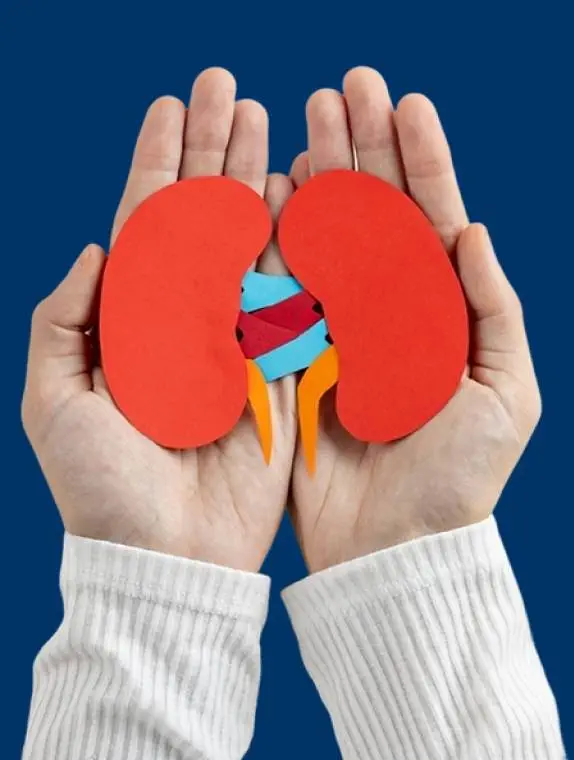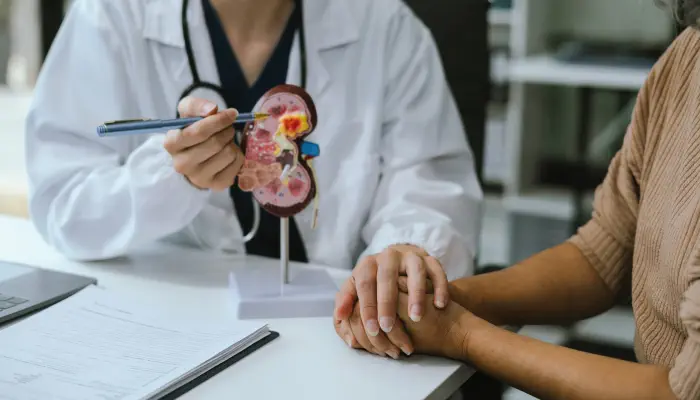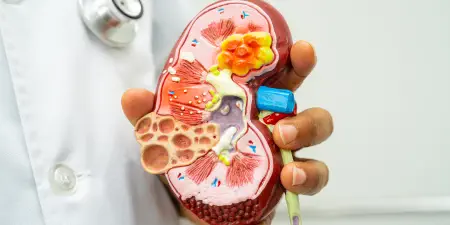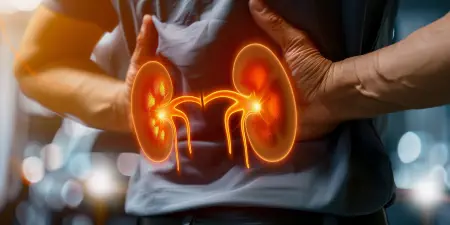Laparoscopic Nephrectomy Surgery

Laparoscopic Nephrectomy: A Modern Treatment for Kidney Cancer
A laparoscopic nephrectomy procedure is a minimally invasive surgery to remove one of the two kidneys that have developed cancer or have ceased functioning. A special instrument called the laparoscope is used to make small incisions in the region between the abdomen and hip to facilitate kidney excision without much damage to the surrounding tissues.
Dr. Aarthy’s vast experience in minimally invasive urological procedures makes her the most sought-after robotic and Laparoscopic urologist in Chennai. She has successfully operated on numerous patients with varying urological issues, significantly improving their quality of life and furthering their treatments.
When is Laparoscopic Nephrectomy Necessary?
Dr. Aarthy may recommend laparoscopic nephrectomy surgery for the following urological conditions:
Revitalise Your Renal Health

- Before Surgery
- What to Expect?
- Post-Surgical Care
Laparoscopic Nephrectomy Procedure: Preparatory Guidelines
Preparing for laparoscopic nephrectomy requires a specific protocol to ensure an easy and uncomplicated process during and after the surgery. Here are some of the standard guidelines to follow:
Consult your doctor at least a week before your surgery for an overall health checkup. This is also an opportunity to clarify any doubts about your surgery.
Take all the standard pre-surgical tests, such as blood and urine analysis. You must also take an ECG to assess your fitness for the surgery.
Take heart and lung tests to ensure your body’s fitness for anaesthesia during the surgery.
Discontinue taking blood thinners at least two to ten days prior to your surgery. Also, continue taking your routine medication unless otherwise advised by your doctor.
Avoid eating and drinking at least 6-8 hours before your scheduled surgery. Also, follow the hospital’s instructions regarding your time of admission.
Laparoscopic Nephrectomy: What to Expect?
Here’s an approximate account of what to expect during your laparoscopic nephrectomy procedure:
A certified anaesthetist will administer general anaesthesia to render you fully unconscious and pain-free during the surgery.
The surgical team will place you on the operating table and position you in a way that allows your surgeon to easily access your kidney.
Your surgeon will insert a catheter into your bladder to deflate it, drain urine, and monitor its output.
Small incisions are made on the surgical site. Your doctor will be using it to insert surgical instruments to gain access to your kidney.
Using carbon dioxide, your surgeon will inflate your abdomen, giving them space to perform the procedure and a detailed view of the internal surgical site.
A high-definition camera and specialised surgical instruments are passed through the incisions to perform the procedure.
The diseased or non-functional kidney is carefully disengaged from the surrounding tissues and removed via an extended incision measuring 2-3 inches in length.
After excising the kidney, the camera and surgical instruments are removed, the incisions are sealed with self-absorbing sutures, and the wound is dressed with sterile bandages.
The excised kidney is packed and sent to a laboratory for an in-depth pathological analysis.
Laparoscopic Nephrectomy Surgery: Post-Surgical Care
The success of your laparoscopic kidney removal largely depends on the post-surgical care to facilitate your body’s healing process. Here’s what you should expect and follow during your recovery phase:
It is expected to experience some pain at the incision sites. For the first few days, you can follow the pain-relieving medication prescribed by your doctor and later use over-the-counter medication.
Although the incision site is bandaged with waterproof dressings, you must take extra care to pat dry the area immediately after showering. This area must be kept clean and dry to prevent infections and promote healing.
Avoid strenuous activities, sports, and heavy lifting for at least six weeks. However, you can indulge in light walking to encourage blood circulation and to keep yourself physically active.
Keep yourself well-hydrated and include vegetables, fruits, and whole grains to facilitate proper bowel movement. If you experience post-surgical nausea, take smaller, more frequent meals.
Consult your doctor according to the scheduled follow-up visits. These consultations are vital to evaluating your post-surgical healing. Your doctor may also want to discuss the pathology analysis results and the further course of treatment.
Limit your protein and salt intake to protect and preserve the health of your remaining kidney. You will also need to monitor its function with regular blood and imaging tests.
Laparoscopic Nephrectomy: The Benefits

Less Pain & Blood Loss
Smaller incisions and advanced techniques minimise blood loss during the surgery, minimise damage to the internal structures, and result in less pain during recovery.
Shorter Hospitalisation
Advanced surgical techniques simplify the procedure and minimise surgical risks, thus helping you recover faster and return home within a few days.
Quicker Recovery
Smaller incisions, less blood loss, minimal to nil risks, and quick-healing surgical wounds help you recover and return to normal activities much faster than in conventional procedures.
Surgical Precision
A high-definition 3D camera provides crystal-clear images of the internal surgical site. This enhanced visualisation enables your surgeon to perform the procedure with on-point accuracy, enabling better outcomes.
Fewer Complications
Smaller incisions and controlled blood loss significantly minimise the risk of infections and complications during and after the surgery.
Prioritise Your Kidney Health








